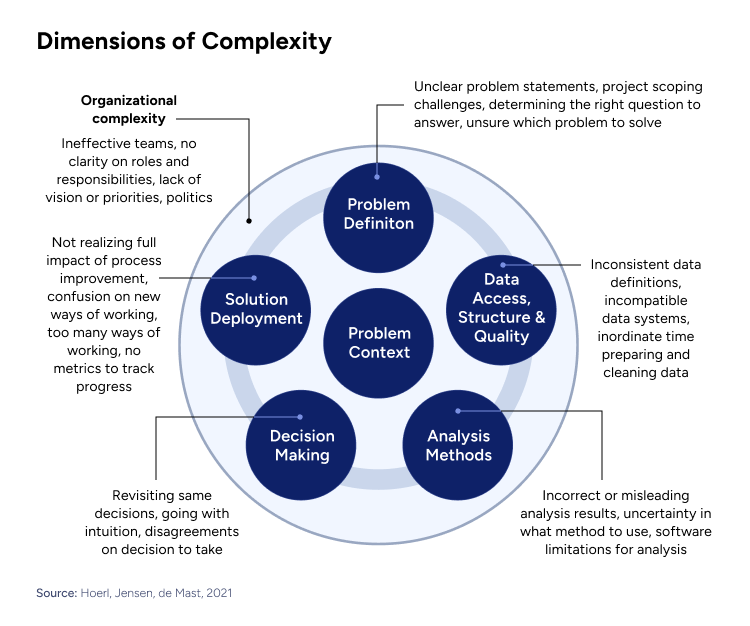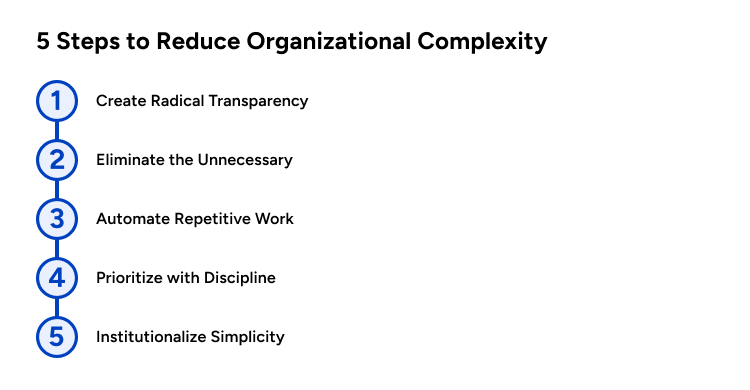The Hidden Cost of Organizational Complexity



Organizational complexity is one of the most overlooked threats to corporate performance, now among the top five barriers to growth for large companies. As decision layers multiply and new tools, processes, and meetings are added, productivity and innovation tend to decline. Employees spend more time managing internal work than delivering results.
Executives often hear the same complaint: “I’m so busy attending meetings, I can’t get any real work done.” This is a symptom of a deeper issue. Instead of removing outdated practices, companies continue to add layers of activity. The result is a bloated operating model that slows execution, drives up costs, and increases employee burnout.
This article outlines the causes and consequences of organizational complexity and provides a five-step framework to reduce it. Leaders who address complexity proactively can unlock faster execution, higher engagement, and better business outcomes.
The Stark Reality of Organizational Complexity
The Dimensions of Organizational Complexity

Organizational complexity arises when multiple interrelated factors disrupt effective problem solving. According to research, five dimensions drive this complexity:
- Problem Definition
Teams often face unclear or conflicting problem statements. Poor scoping, ambiguous goals, and misaligned expectations make it difficult to determine what issue needs solving or who owns it. - Data Access, Structure, and Quality
Inconsistent data definitions, incompatible systems, and missing information create friction. A large share of time is spent cleaning or reformatting data instead of analyzing it. - Analysis Methods
Complexity increases when teams use inappropriate, outdated, or overly complex methods. In many cases, results are misleading due to tool limitations or methodological gaps. - Decision Making
When decisions are based on intuition, politics, or unclear criteria, progress stalls. Teams revisit the same issues repeatedly, wasting time and eroding trust. - Solution Deployment
Even strong solutions fail when implementation is poorly managed. Conflicting processes, unclear responsibilities, and a lack of follow-through lead to delays and lost impact.
Each of these dimensions interacts with the others. Without addressing them systematically, organizations remain trapped in a cycle of inefficiency and poor execution.
The Impact of Organizational Complexity
Organizational complexity reduces productivity and weakens team performance. Senior executives now spend 23 hours per week in meetings, up from 10 hours in the 1960s. As complexity grows, time and focus shift from execution to internal coordination. Common symptoms include:
- Overloaded calendars and back-to-back meetings
- Long email threads and excessive reporting layers
- Unclear roles and duplicated responsibilities
- Multiple overlapping systems and tools
Several data points highlight the cost of internal overload:
- 67% of employees say meetings prevent real work
- 61% of innovation efforts are blocked by internal processes
- Companies that reduce complexity see a 40% increase in high performers
Left unaddressed, organizational complexity slows down decisions, limits innovation, and increases employee burnout.
The Root Causes
Understanding what drives organizational complexity is essential for reducing it. In many companies, internal complexity grows gradually through decisions made with good intentions, but without discipline.
Leaders introduce new tools, processes, and structures, but rarely remove outdated ones. Over time, this creates friction, delays, and inefficiencies. Four root causes explain why organizational complexity continues to expand:
Misaligned Incentives
Many leaders are rewarded for launching new initiatives, adopting technologies, and creating new departments. For instance, a study by Deloitte found that 48% of leaders are seen as driving change and innovation, and just 44% are recognized for building talent for competitive advantage and simplification initiatives.
Progress is measured through visible activity (such as new systems or programs) rather than operational clarity. This encourages leaders to “add” rather than streamline. As a result, organizational complexity increases, even when simplification would create more impact.
Underestimated Complexity of New Initiatives
Executives often underestimate how much additional burden each new initiative adds. What may seem like a minor change (such as introducing a new report or software tool) can trigger a cascade of unintended consequences, including additional approvals, more complex reporting structures, and increased coordination demands across departments.
Each added layer consumes valuable time and focus. According to McKinsey & Company, organizations that undergo transformation efforts typically capture only 67% of the intended financial benefits, in part due to hidden complexities and inefficiencies introduced during execution. As the number of interdependent processes grows, execution slows down, and teams gradually lose focus on core priorities, ultimately undermining the very performance gains the initiatives were meant to achieve.
Risk Aversion in Decision-Making
Eliminating internal processes or tools often feels riskier than maintaining them. Approving a new system may seem safer than being held accountable for removing something perceived as essential. This mindset fosters inertia. Even when employees recognize that a tool or workflow is obsolete, they may hesitate to act. Fear of negative consequences hinders simplification. Over time, this risk-averse behavior becomes embedded in the company culture, leading to increased complexity.
Research indicates that risk aversion can impair decision-making. A study published in Frontiers in Psychology found that greater risk aversion is associated with poorer decision-making. This suggests that risk-averse tendencies can lead to suboptimal decisions, potentially reinforcing inefficient processes within organizations.
Furthermore, a report by Marsh McLennan highlights that 40% of business leaders and 41% of corporate development professionals believe that risk aversion undermines transaction success. This underscores how a culture of risk avoidance can impede organizational progress and adaptability.
Self-Marketing Through Addition
Leaders often gain recognition by launching new projects that produce visible outputs. New systems, processes, or task forces serve as tangible proof of impact. Challenging the value of an existing structure rarely creates the same visibility. Career advancement often favors those who add complexity, not those who reduce it. This creates a cycle where internal structures grow, even if they no longer support business goals.
Research indicates that organizational complexity can hinder growth. A study by Harvard Business Review found that as companies expand, they frequently become more complex, leading to slower decision-making and reduced agility. This complexity can result in a "stall-out," where growth stagnates despite previous success. The study emphasizes the importance of simplifying structures to maintain momentum and align with business objectives.
To counteract this, organizations should recognize and reward efforts aimed at simplification. By valuing the elimination of outdated processes and the reduction of unnecessary complexity, companies can foster a culture that prioritizes efficiency and adaptability over mere expansion.
The Hidden Costs of Organizational Complexity
Unchecked organizational complexity impacts companies in five critical areas. Each additional layer (whether a meeting, tool, or process) adds time, cost, and friction. As internal structures grow, productivity declines, innovation slows, and employee fatigue increases. The data shows clear and specific risks.
1. Reduced Productivity
McKinsey estimates that knowledge workers lose up to 28% of their workweek to administrative tasks. These tasks pull time away from strategic priorities. Employees spend hours coordinating, updating reports, or preparing for meetings, while real project work is delayed.
As these inefficiencies compound, deadlines slip and execution weakens. Teams focus on activity instead of output. Leaders should shift performance metrics from volume of work to results delivered.
2. Stifled Creativity
Internal bureaucracy, if not used properly, is a major obstacle to innovation. When approvals require multiple layers and risk avoidance becomes routine, employees stop experimenting. A culture of control signals mistrust. Over time, this discourages initiative. Talented professionals either lower their expectations or leave for less rigid environments.
3. Increased Employee Burnout
High organizational complexity leads to burnout: employees in complex environments report significantly higher stress and disengagement. Repeated exposure to fragmented tasks, back-to-back meetings, and unclear ownership creates emotional fatigue.
Burned-out employees are more likely to leave, which increases turnover costs and disrupts team performance. Companies should introduce regular “overload checks” to detect early signs of employee strain.
4. Escalating Costs
Duplicate systems and overlapping processes drive hidden expenses. IDC studies indicate that companies may lose up to 30% of their annual revenue due to inefficiencies they don’t measure, such as unused software licenses, redundant approvals, and duplicated reporting. These figures highlight the critical need for organizations to assess and streamline their operations to mitigate hidden costs and enhance operational efficiency.
When teams are tied up with low-value tasks, high-value projects are delayed or deprioritized. As opportunity costs accumulate, margins shrink year after year.
5. Strategic Paralysis
Organizational complexity often hampers swift decision-making. Over 80% of organizations report struggles with decision-making, frequently due to unclear processes and excessive layers of approval.
This sluggishness can lead to missed opportunities in fast-paced markets. Moreover, leaders who make quick, clear decisions are 4.2 times more likely to sustain organizational performance over time. Therefore, reducing unnecessary complexity and streamlining decision-making processes are critical for maintaining agility and competitiveness.
5 Steps to Reduce Organizational Complexity
Solving organizational complexity requires a structured and disciplined approach. Adding more tools and processes often feels like progress, but without deletion, it only increases internal friction. The following five steps help companies reverse complexity and build a simpler, faster operating model.

Step 1: Create Radical Transparency
Start with a complexity audit. Map out meetings, reports, systems, and approval flows to understand where time is being lost. Use real data from time tracking and employee feedback to reveal hidden inefficiencies. Deloitte reports that companies conducting regular process reviews improve productivity by up to 20%. Transparency gives leaders a baseline to make simplification decisions.
Step 2: Eliminate the Unnecessary
Adopt a zero-based mindset. Treat every internal process, meeting, and report as optional until justified. Instead of asking what to add, focus on what to remove. Amazon uses small, focused teams to avoid coordination overload. This mindset helps reduce organizational complexity and improves speed and ownership.
Step 3: Automate Repetitive Work
Identify repetitive, low-value tasks and replace them with automation where possible. Gartner shows that workflow automation can raise productivity by up to 25% when deployed effectively. Streamlining approvals, reporting, and scheduling allows teams to focus on work that requires judgment and creativity, not administrative repetition.
Step 4: Prioritize with Discipline
Teach leaders to say “no” as often as they say “yes.” Many organizations promote based on output volume instead of value delivered. Shift performance criteria to reward simplification, not expansion. Berkshire Hathaway’s minimal headquarters reflects this culture, focus, and discipline over scale and noise.
Step 5: Institutionalize Simplicity
Simplicity must be sustained, not treated as a one-time effort. Build internal processes to track additions and conduct regular “complexity health checks.” Companies like Toyota integrate this thinking through the continuous removal of waste. Long-term reduction of organizational complexity depends on repeatable habits, not one-off projects.
Lessons from Industry Leaders
Organizational complexity is not a new challenge, but companies that reduce it consistently outperform their peers. Several well-known examples illustrate what it looks like to simplify at scale:
How Leading Companies Simplify to Win
Apple
When Steve Jobs returned to Apple in 1997, he eliminated 70% of the company’s products and projects. By removing excess and focusing on core strengths, Apple laid the foundation for its growth over the next two decades.
Google
After acquiring Android, Google avoided unnecessary bureaucracy. It preserved the autonomy of key teams, which helped Android scale quickly and become the world’s dominant mobile OS.
Netflix
Netflix’s “Freedom and Responsibility” culture emphasizes autonomy over rules. By deliberately avoiding new policies unless necessary, the company keeps innovation flowing and bureaucracy low.
Spotify
Spotify uses small, cross-functional teams (“squads”) to reduce dependencies and move fast. This structure removes bottlenecks and cuts down the time required for decision-making.
My Experience at Consultport: Simplicity Drives Client Results
In my past transformation and organizational design projects at Consultport, I’ve seen firsthand how complexity silently erodes performance. In one case, a global manufacturing client was running 200+ internal initiatives, but only 12% were actively delivering value as they contribute to strategic goals.
By conducting a thorough audit and applying a zero-based approach, we helped them eliminate over 40 redundant workflows and consolidate five overlapping reporting tools. Within five months, project delivery speed improved by 30%, and employee satisfaction scores rose across teams.
Many executives underestimate how much time and cost are locked inside redundant systems. But when they see the impact of removing friction (faster decisions, more focused teams, fewer missed opportunities), they rarely go back to the old way of working.
The Bottom Line
Simplicity is often mistaken for minimalism or operational trimming. It’s not. It’s about focusing effort where it creates value and stopping what doesn’t. As AI, remote work, and new market disruptions increase complexity, companies that manage to stay lean will move faster and adapt better.
Organizational complexity kills speed. It slows down decision-making, inflates costs, and reduces innovation. Leaders must treat simplification as a strategic function, not just an operational fix. The companies that win in the next decade will not be those that do the most, but those that focus best.
Cut the noise. Eliminate the unnecessary. Build systems that scale without bloating. That’s how modern companies stay competitive while keeping their people engaged and focused.
For companies looking to simplify, working with platforms like Consultport can help you find the right consultant to address organizational complexity and drive sustainable change.
“Simplicity is the ultimate sophistication.”
— Leonardo da Vinci
on a weekly basis.


